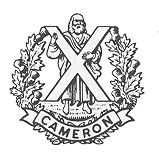 | |
 | |
| Location | Winnipeg, Manitoba, Canada |
|---|---|
| Type | The Queen's Own Cameron Highlanders of Canada military museum |
The Queens Own Cameron Highlanders Museum is a military museum in Winnipeg, Manitoba. The museum at the Minto Armoury is dedicated to Manitoba's famous Scottish regiment, The Queen's Own Cameron Highlanders of Canada, which was first raised in 1910.

